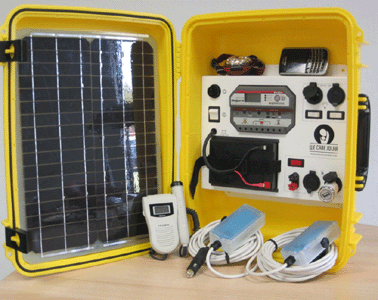A group called We Care Solar has developed an innovative product that provides solar electricity to health care workers in developing countries.
Before she received her Solar Suitcase, Esther Madudu, a Ugandan midwife, delivered babies at night by holding a cellphone in her teeth.
Open a suitcase and you’ll see a combination of LEDs, batteries and solar panels that can power lights, headlamps for surgery and refrigerator to store blood. It can power a dining room, a study area or outdoor halls for security.

What’s in a Solar Suitcase? LED medical task lighting, a universal cell phone charger, a battery charger for AAA or AA batteries, and outlets for 12V DC devices. The basic system comes with 40 or 80 watts of solar panels, and a 12 amp-hour sealed lead-acid battery. An expansion kit is available for using larger batteries.
The economical, easy-to-use portable power unit provides health workers with highly efficient medical lighting and power for mobile communication, computers and medical devices.
Key design features include:
- Whole System Integration – The lighting appliances and power production components are delivered as one unit, designed for daily use.
- Safety – The sealed batteries can safely be stored inside health facilities; the low-voltage DC system avoids shock hazard and includes overcurrent protection.
- Low Maintenance – There are no fuses to replace, and no regular battery maintenance is required. Battery replacement is estimated to occur every 2 years.
- Durability – Our high quality components are designed for longevity, even in harsh environments.
- Simplicity – One switch turns on the system; another turns on lights and charges devices. The system is plug-and-play and can be installed without need for an experienced solar technician.
- Expandability – The 15 amp modular system is designed for expansion and can accommodate up to 200 watts of solar panels and a 140 amp-hour sealed battery.
In California, the State Superintendent of Public Instruction just launched a $3.2 million program to help prepare high school students for cleantech jobs, one of the most sought after skillsets by students.
After Alan Jensen, a teacher at Central Coast High School learned about We Care Solar, he got his class involved in making Solar Suitcases.
Jensen’s class plans to ship solar suitcases wherever they’re needed in developing countries. About 45 students are building suitcase in a 10-week project – each one costs about $1000.
The students know how to wire the solar package because they learned how to as part of Jensen’s green technology class – they helped install a solar PV panel on the roof of their classroom, and built solar-powered balsawood cars and house models with solar panels on the roof, reports the Monterey Herald:


19 volts is the usual voltage for laoptp power bricks, but maybe yours is really 18. That 3.2 amps is generally the maximum power drawn, when the laoptp is up and running disks, LCD backlight, and all. So if you want to charge the battery while the laoptp is off, 1.25 amps at 18 volts should be enough.However, you will need to be certain that your panel will really produce 18 volts and 1.25 amps at the same time. A panel sold with an open circuit 18 volts is generally intended to run at 14 volts or so, to charge a 12 volt battery. At 18 volts, the current will be minimal if you can even get that high on a warm day.Can’t hurt to try, I suppose. Hook it up, and measure the voltage when connected to the laoptp. If it stays at 18, you’re good to go. If it drops, you need more panel.